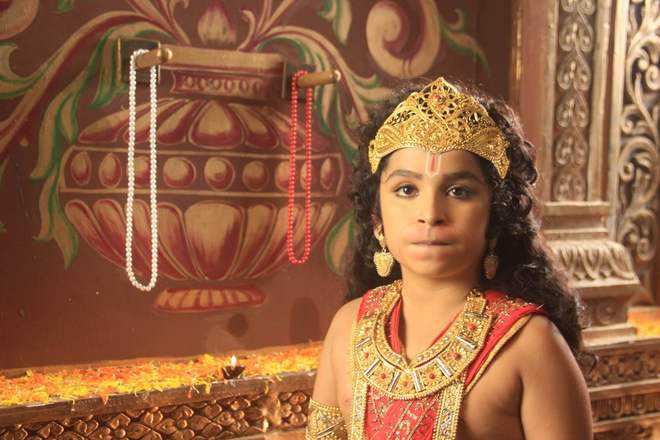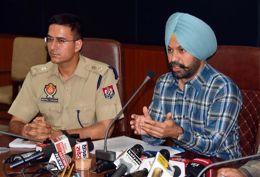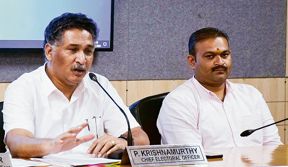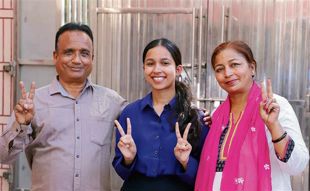
A still from Sankatmochan Mahabali Hanuman
Nonika Singh
“Within infinite myths lies the eternal truth.” — Devdutt Pattanaik
Of course, decoding this truth is never easy, more importantly it’s never one sided or even simplistic. There can be no formulaic representation of it, nor can a reductionist narrative describe it. As the Yajurveda tells us; truth is one but wise men see it as many.
Chitra Banerjee Divakaruni’s Palace of Illusions can tell it from the fiery Draupadi’s point of view and also hint at the unspoken love between Karan and Draupadi. Her next Under the Sorrow Tree will lend voice to Sita, not as a picture of compliance as she is often perceived to be but much more. In Ajaya, Anand Neelakantan recreates the Mahabharata from Duryodhana’s point of view and in Asura: Tale of The Vanquished, his take on the Ramayana is from Ravana’s perspective. Amish Tripathi’s trilogy on Shiva both humanises and deifies the creator destroyer.
Since time before the written word mythology has fired and ruled human imagination like few genres have.
Writers in many Indian languages have interpreted our mythical tales, adding their own twists to it. In recent years the mythology bug seems to have bitten Indian writers in English with even more intensity than the usual. And their take on mythical tales has caught the readers’ fancy.
One of the most successful mythology writers of our times is Amish Tripathi. The author of stupendously successful Shiva trilogy comprising The Immortals of Meluha, The Secret of the Nagas and The Oath of the Vayuputras, he attributes the renewed interest in mythology to the growing awareness about our cultural roots. He says, “Mythology has always been part of our cultural DNA and been the most popular genre. What is new is how it’s being re-imagined and how there is a hunger post-1990s to listen to our own stories in our own voices.”
Neelakantan, however, asserts that Indian English writers are merely treading a familiar territory. As compared to writers in regional Indian languages, their (his included) endeavours are in the infancy stage. “Take Jnanpith awardees for instance, most of them have at least one exposition of the Ramayana or the Mahabharata to their credit,” he adds.
Envisioning mythology from different vantage views, too, is a time-tested concept. Though in today’s troll-ridden times when actor Kamal Haasan is hauled to court for seemingly reasonable remarks on the Mahabharata, it could be fraught with many pitfalls. For one, there is the chance of being misunderstood as a religious fanatic.
Tripathi, anyway, stands a proud Hindu who approaches his subject with both respect and love. “I generally worship the gods I write about.” Indeed, in a country where more than one thing has become a holy cow, irking sensibilities is a recurring possibility. But Tripathi is adamant, “Except for a fringe extreme section, Indians of all faiths are both deeply religious and intrinsically liberal at the same time. India does allow for the space where many truths can coexist.”
Pattanaik, too, approaches the subject with a deep respect. “Whenever you write a story you need to be sensitive to the readers. Some writers find pleasure in offending readers and likewise, some readers get upset whenever a writer has a different point of view. If you ignore the extremists on either side, and are generally sensitive and mature, things are not so bad. Luckily, in a recent judgment, the Supreme Court has said that unwitting ‘insults’ to religion must not be prosecuted.
Neelakantan has turned many an epic tale upside down, even aired his misgivings about what the Gita truly stands for. But he has never felt the heat even when he speaks in the voice of the antagonist. His reasons — “Heroes have had their say for too long.” But what really fascinates him about the Indian mythology is its grey shades. “In our Puranas, there is nothing or no one absolutely good or bad. Good and bad are only relative. Then there is karma for which we all have to pay, even Lord Krishna can’t escape his.”
In Jaya: An Illustrated Retelling of the Mahabharat, Pattanaik writes, “Through Karna, Vyasa reiterates that our knowledge of the world is imperfect based on perceptions and false information. We are surrounded by Kuntis who hide the truth in fear. We are surrounded by Karnas, villains, who are actually brothers.”
Since history (mythology too) is essentially told from the victor’s point of view, many truths remain uncovered. As writers, their task is to fill in these gaps and make silences speak the way they perceive it. Tripathi believes there are many liberal messages in our ancient scriptures, including about women empowerment, which need to be told and retold. However, the manner in which these are conveyed in umpteen television serials could be devoid of the myths’ inherent complexity and maturity. Neelakantan, who has also written for television serials such as Siya Ke Ram, Ashoka and Mahabali Hanuman, concurs, “The very nature of the commercial beast that television is, it doesn’t allow for any deep probing or unconventional deliberation. When I write for television, it’s purely for money. ”
Tripathi, however, is all for all kinds of retelling. “Any interpretation in any part of the country in any language and in any medium is welcome.” The author, whose million-dollar deals with filmmakers for the rights of his book have generated a buzz, wouldn’t mind a television adaptation of his books, provided the production values are at par.
Pattanaik’s journey into the world of mythology has comfortably straddled both worlds. He has written 30 books till date and his television show Devlok with Devdutt has, too, been converted into a book. Many of his literary forays like My Gita have, however, evinced mixed response. Some critics call him too cautious. But that is only expected in a country where lines between religion and myth often blur.
Whether myth is religion or not, Neelkanatan says, “In India there is no religion. Hinduism has always been a way of life, but now Hindutava is emerging as a dangerous alternative.” What he loves about mythology is its non-judgmental tenor. He says, “The morality that we are talking of today is a Victorian concept and has little to do with our scriptures.” That’s why, perhaps, the appeal of our myths cuts across religious boundaries and the tales endure and lend themselves easily to manifold enunciations.
Right now India, rather those reading Indian English writings, otherwise bereft of their cultural stories, seem to be enjoying the mythological ride. Since these are missing from our education curriculum and oral tradition of retelling is all but fading away, a whole lot of writers have taken it upon themselves to weave a tapestry of old and new threads of mythology, often in resoundingly successful ways.
As Pattanaik puts it, “All myths make profound sense to different people whether religious or secular, thought not to everyone. These cannot be rationalised beyond a point. In the final analysis, you either accept these or you don’t.”

























